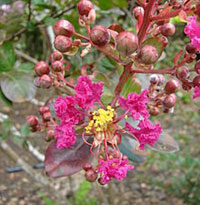Plant

Nurseries place landscape plants on sale as spring winds down. Hand-water the new plants every other day through the summer. They will need frequent deep watering, so sprinkler irrigation will not be enough to get them established.
Itís hard to believe that we have barely got our spring gardens in and it is already time to start thinking about the fall garden. Vegetable transplants for fall such as tomatoes, peppers, and eggplants can be started from seed in early June for transplanting in July. Starting fall transplants is fairly easy because they can be grown outside. Keep evenly moist until the seeds come up; then make sure the seedlings get sun for most of the day. Morning sun and afternoon shade is beneficial. Transplants are usually ready in about six weeks after seeds are planted.
Early in June heat-tolerant annuals such as moss rose, pentas, lantanas, Dahlberg daisies and gomphrenas can still be planted in sunny places. Dragon Wing and wax begonias and flowering tobacco for shade.
Lawns: Plant bermuda from seed or sod. Plant St. Augustine in parts of the lawn that receive some shade.
Watering
Water in the morning. It is normal for plants to look a little sad during the day because they have transferred their water reserves to their roots. You may notice that later in the evening the plants will perk back up because they are drawing their water reserves from their roots back to their leaves.
Water tomatoes consistently to help avoid blossom-end rot.
Water newly laid sod for 15 to 20 minutes every day for a week. For the next 7 to 10 days, water the sod every other day is it does not rain. Apply 1/2 inch of water to the lawn twice a week for several weeks if the weather is dry.
Established lawns: One inch of water per week whether from irrigation or rain. If water begins to run off before you have watered 1 inch, water those sections in two 30-minute segments giving the water a chance to soak in between waterings. Your grass it getting dry when the blades fold or roll, it turns a drab, olive-green color, and you leave footprints in the blades when you walk across it.
Mulching helps keep the soil cooler as well as helping retain moisture in flower beds and vegetable gardens
Prune
Spring annuals: Remove spent flowers, seed heads, and flower stalks on coleus, lambs ear and basil.
Pinch growing tips of chrysanthemums to encourage branching for maximum bloom in the fall.
Blackberries: Tip prune new canes to encourage branching. Remove canes that have borne fruit by cutting them back at the base. They will die at the end of the season, so itís good to get them out of the way of the new growth that will produce next year.
Fertilize
If flowering annuals are looking pale or low in vigor, try an application of soluble fertilizer or sprinkle the bed with a 3-1-2 ratio fertilizer. Use in moderation as over fertilizing can lead to lush growth with fewer flowers.
Lawns: Use a high-nitrogen fertilizer with at least half in a slow release form. Common bermuda every eight to nine weeks. St. Augustine early in the month
Be on the lookout
Spider mites: Look for tiny pale or white speckles on the upper surface of foliage. Fine webbing may be seen on plants with heavy infestation.
Weeds: Weeds love fertilizer and water just as much as our flowers. Handweeding regularly and mulching helps overall control.